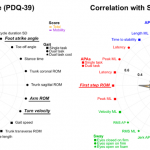Cerebellar White Matter Damage Is Associated With Postural Sway Deficits in People With Multiple Sclerosis
Objective
To assess how postural sway deficits during eyes open and closed relate to the integrity of cerebellar peduncles in individuals with multiple sclerosis (MS).
Participants
Twenty-nine adults with MS (Expanded Disability Status Scale: 2-4) and 15 adults without MS were recruited (N=44). Inclusion criteria for all participants were ability to maintain balance independently by standing on toes for 3 seconds, and no known biomechanical conditions affecting balance.
Main Outcome Measures
Postural sway using body-worn, inertial sensors during quiet standing, integrity of cerebellar peduncles quantified using diffusion-tensor imaging and clinical assessment scales for ataxia and balance.
Results
Radial diffusivity of the inferior cerebellar peduncle was related to postural sway measures during both eyes open and closed. In contrast, radial diffusivity of the superior cerebellar peduncle was related to postural sway only in stance with eyes open.
Conclusions
The inferior cerebellar peduncle, which carries somatosensory information to the cerebellum, contributes to control of standing balance with or without visual inputs, consistent with the high dependence on somatosensory information for posture. The superior cerebellar peduncle, which carries cortical information to the cerebellum, contributes to control of standing posture only when vision is available. Radial diffusivity of the inferior cerebellar peduncle was related to reactive balance control, whereas radial diffusivity of the superior cerebellar peduncle was related to the kinetic component of the ataxia rating scale.
Authors
Geetanjali Gera, Brett Fling, and Fay Horak
Full Article Link: https://www.sciencedirect.com/science/article/abs/pii/S0003999319310020





